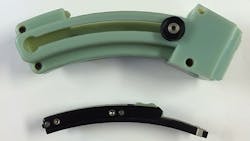Hybridized 3D-Printed Part Combines Plastic and Metal
When a client quickly needed a working prototype of a rifle magazine, the designers and technicians at Baklund R&D, Hutchinson, Minn., knew they would have to use hybridized 3D printing. It’s a manufacturing technique that combines parts made of metal, wood, or molded plastic with printed thermoplastic parts or housings. In this case, a high-wear component was machined out of aluminum and integrated into the printed thermoplastic magazine.
Hybridized 3D printing was developed to overcome the structural and aesthetic shortcomings of printed thermoplastics. Printed plastics are weaker than molded plastic and in most cases will not endure the abuse often required during testing. One option is strengthen components, but then they may need to be up to twice as thick as molded plastic to withstand similar forces. Many times this is not an option due to the need to maintain accuracy in parts size and operation.
Hybridization, on the other hand, creates accurate prototypes of final parts out of plastic, wood, steel, aluminum or virtually any other type of material that is required. The hybridized part can meet specifications for high-wear components, the need to have different types of materials and densities in specific areas of the prototype, or simply for aesthetics.
A great example of this can be seen in the assembly recently developed by Baklund R&D, which integrated an aluminum high wear section on a rifle magazine. Combined with the ability to quickly 3D print the rest of the model, hybridization not only let Baklund build a prototype that could withstand the required testing, but also let the company deliver the project to the customer more quickly than other suppliers, who would have relied only on additive 3D –printing processes.
As this hybridization technique becomes an accepted technique, engineers should be able to create more functional prototypes, as well as more production-ready products. The hybridization technique will translate to a reduction in time to market and reduced development costs; it will also allow for designs to be optimized beyond their current limitations, as designs that were not possible before can now be physically validated before production even begins.
